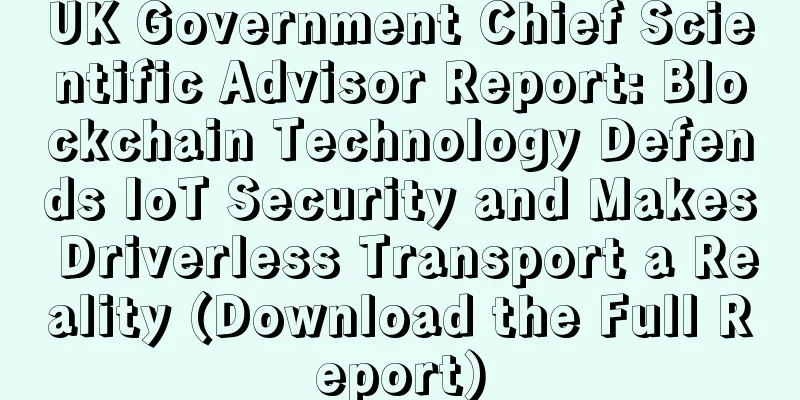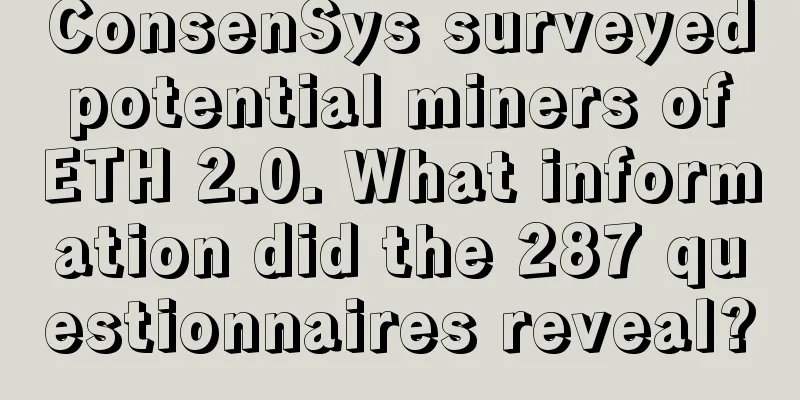UK Government Chief Scientific Advisor Report: Blockchain Technology Defends IoT Security and Makes Driverless Transport a Reality (Download the Full Report)

|
The use of blockchain technology is not limited to cryptocurrencies - it can also be used for many government services - and the technology can also play an important role in ensuring the security of the Internet of Things. The potential use cases for blockchain are becoming more and more numerous. For example, this technology can be used to enable driverless transportation - cars, buses, planes, etc., which are all important components of the intelligent future of the Internet of Things. The inherent potential of blockchain technology can make autonomous transportation systems immune to cyber attacks. It all comes down to how blockchain is used. Blockchain is a decentralized electronic ledger technology. This ledger of encrypted transactions is public and can be distributed around the world. Mark Walport, the UK government’s chief scientific adviser, said that a successful attack on a blockchain ledger would require tampering with all instances of the ledger at the same time, which is basically impossible. Walport wrote a report on distributed ledger technology (download the full report) that combines global case studies on blockchain in terms of trust and interoperability. Government use of blockchainWalport wrote in his report that although blockchain was born in the field of currency, it can also be used for many other types of transactions, from real estate to government records. Blockchain can be used to collect taxes, record land and property registries, and more. The beauty of blockchain is that there are copies of this ledger on computers around the world - it is actually this feature that allows cryptocurrency assets to be transferred and recorded without the need for external verification. In fact, some of the world’s largest banks are working together to explore how blockchain can improve transaction auditing, increase efficiency and reduce costs. According to the Walport Report, Estonia’s largest independent bank, LHV Pank, has issued cryptocurrency securities. Blockchain and the Internet of ThingsIf every self-driving car is an autonomous device—part of an overall system—centralized failures are essentially eliminated. Blockchain can then improve the security of implementing individual autonomy-enabling devices. Walport said:
While blockchain may not yet be available to ride-hailing companies, which must check drivers and perform some tasks guided by human judgment, it is already being tested for other transportation uses. Plex.AI, a Canadian auto insurance technology startup founded in 2015 and based in an Ontario incubator, has developed a car telematics platform that is reportedly able to provide real-time remote diagnostics about a car to insurers. The technology uses the Ethereum blockchain, machine learning, and artificial intelligence to generate information about customers who get quotes and register through the Rover app. Amos Meiri, co-founder of Israeli blockchain technology company Colu, said:
|
<<: IFPI2016: Standardization, competition and win-win situation
>>: 10 R3 Bank Members Successfully Test Blockchain Identity Registry System
Recommend
The face of a woman who loves freedom and travel
Freedom is what many people yearn for. Many women...
All you need to know about Filecoin
DuangDuangDuang ~~ Your little cutie suddenly app...
US GAO warns Bitcoin used in cyberattacks against banks
The federal agency that regulates U.S. banks has ...
What does a mole on the back mean?
When facing the mirror, we can only see our front...
USDT and other stablecoins have become the financial settlement infrastructure of the United States? An article on the evolution of stablecoins
A piece of news in the industry recently caused a...
How to read women's fortune through palmistry
As the saying goes, people die for money and bird...
What does it look like to be an ordinary person?
The facial features of those who are able to beco...
Should the inventor of Bitcoin win the Nobel Prize in Economics?
Since its birth in 2008, Bitcoin has quickly attr...
There are two interpretations of a woman with a mole on her left cheek
Moles are divided into left and right, just like ...
How to read a woman's face and mouth shape
The mouth is one of the five facial features. In ...
Men with triangular eyes are mostly selfish and heartless
Are men with triangular eyes okay? In physiognomy...
Is it true that girls with nasolabial folds have bad luck in marriage?
Nasal folds originate from the cheekbones and are...
Palmistry ridges diagram
The palm is covered with skin, and the surface of...
Analysis of women's facial features without eyebrows
Analysis of women's facial features without e...
What does a woman with a mole on her right earlobe mean?
Generally, a well-shaped earlobe is considered a ...









